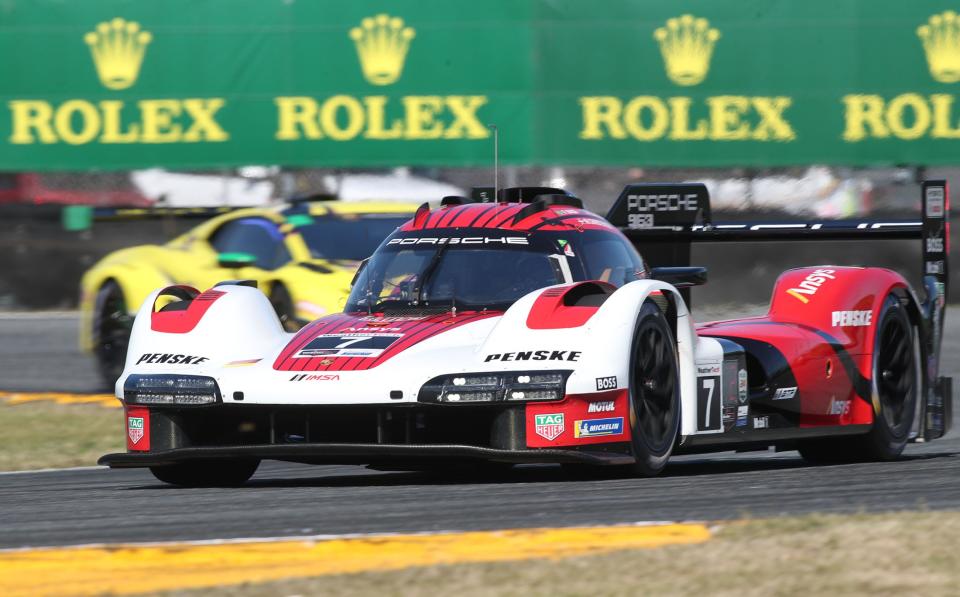'Green racing' hits Daytona: hybrid engines, renewables in racing fuel at Saturday's Rolex 24
When the cars roll off the starting grid for the Rolex 24 at Daytona Saturday, it may be the greenest race yet for the International Motor Sports Association’s top class.
From fully integrated hybrid engines that launch the cars off pit road with electric power to using fewer tires and renewable fuels, IMSA aims to showcase the industry’s sustainability efforts.
Endurance racing, such as the 24 Hours at Daytona, has long been a laboratory for manufacturers to test concepts and trade technologies with street cars and that creative tradition continues, said IMSA President John Doonan.
IMSA is among several racing series looking to an array of more sustainable technologies as the industry responds to growing climate change concerns.
Will your next car look like one of the sleek prototypes racing this weekend? Maybe not. But Doonan said the energy and excitement of the engineers in the performance of the greener technologies will make its way back to production car manufacturing.
Rolex 24 at Daytona: How to watch the race and understand the car classifications
MORE: Electric vehicles go 'Nitro-fied' in new event

A 'green' commitment
It’s been more than 15 years since officials with IMSA's former American Le Mans series and the Society of Automotive Engineers formed a “strategic alliance” with the Environmental Protection Agency and the Department of Energy. The group drafted “green racing” principles to promote sustainability and fuel efficiency.
They wanted motorsports to serve as “the ultimate laboratory” for manufacturers to showcase newer, more efficient technologies and performance, said Doonan. Today the partnership continues, giving car enthusiasts and fans a chance to see the emerging, sustainable technologies.
As IMSA considered its next steps, Doonan said the hybrid seemed like “a good bridge” to the future. Four manufacturers brought hybrids for the inaugural Grand Touring Prototype class: Acura, BMW, Cadillac and Porsche.
The IMSA platform gives manufacturers the ability to “showcase what we do from a technology perspective, from a performance perspective, and from an aerodynamics perspective,” said Rory Harvey, vice president Cadillac Global. “It gives us the ability to transfer technology across to our road cars."
Cadillac has stated its ambition to be all-electric by 2030, Harvey said. So it’s looking to learn, develop and “take those lessons into our EV portfolio as we move forward.”
At Daytona International Speedway
Among the greener elements to be found in the prototype cars and garage this weekend are:
Unified powertrain and hybrid systems that accelerate off pit road with electricity, conserving fuel and extending the time cars can race
Energy captured from rear braking feeds back into the system.
Double stints for the tires by Michelin, which states it plans to achieve tires made solely from recycled or renewable materials by 2050.
A VP Racing fuel for the top class that’s 80% renewable; 64% of that from a second-generation non-food chain product, Doonan said. “The hope would be to be at 100% renewable by 2025.”
A semi-trailer serving as a business center sports a new flat panel solar array and battery storage that could run completely off the grid for three hours.
In some ways, the hybrids return to auto racing’s roots. An electric car set the world’s first land speed record in 1898, the same year Ferdinand Porsche designed the first hybrid.
Since an Audi hybrid won the 24 Hours of Le Mans in 2012, three racing series have added classes to allow electric cars to compete.
A huge challenge
Manufacturers, engineers and teams describe the transition of the prototypes from concept to track as a massive challenge, especially in light of the pandemic and worldwide supply chain problems.
#IMSA - Enjoy some #Porsche963 images from last weekend's @IMSA #Roar24 @DAYTONA #Raceborn #PorschePenskeMotorsport #GTP #LMDh pic.twitter.com/lBa39bP6cn
— Porsche Motorsport (@PorscheRaces) January 24, 2023
Porsche committed to the new prototype in December 2020, wooed by the opportunity to compete in IMSA's Weather Tech SportsCar Championship and the World Endurance Championship, including Le Mans, in the same car.
It wasn’t a long turnaround, said Christian Eifrig, technical project manager for Porsche's 963. Getting the car light enough to meet the overall weight requirement, considering its more than 16,700 parts and multiple cooling systems was a massive challenge.
Its entire powertrain, with the twin-turbo V8 engine and electrical motor, is directly connected, Eifrig said. Instead of a typical starter and generator, the hybrid system and its high voltage battery take over until the driver releases the clutch to start the engine.
What’s the next 'green' step in racing?
Could stock car racing be the next to dip its toes into hybrid technologies?
NASCAR, Hendrick Motorsports, Chevrolet and IMSA are scheduled to enter a Cup series car — the Camaro LZ1 — as the “Garage 56” demonstration car for the 100th anniversary of the 24 Hours of Le Mans in June. Technical details haven’t yet been announced, but the Daytona Beach News-Journal reports the rules require a hybrid component.
IndyCar is scheduled to debut hybrid systems in 2024.
As for IMSA’s next steps, Doonan said they’ll continue discussions with the industry.
“We want to be responsible, but we want to make sure our audience is still intrigued by what they’re seeing,” he said. “We can still be entertaining with the sounds and sights of the cars, but also be more environmentally friendly.”
This article originally appeared on USA TODAY: 2023's Rolex 24 Hours at Daytona showcases 'green racing'

 Yahoo Movies
Yahoo Movies 